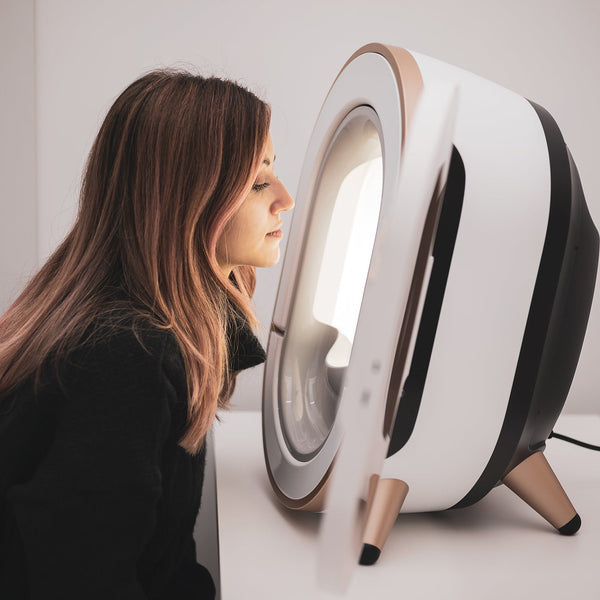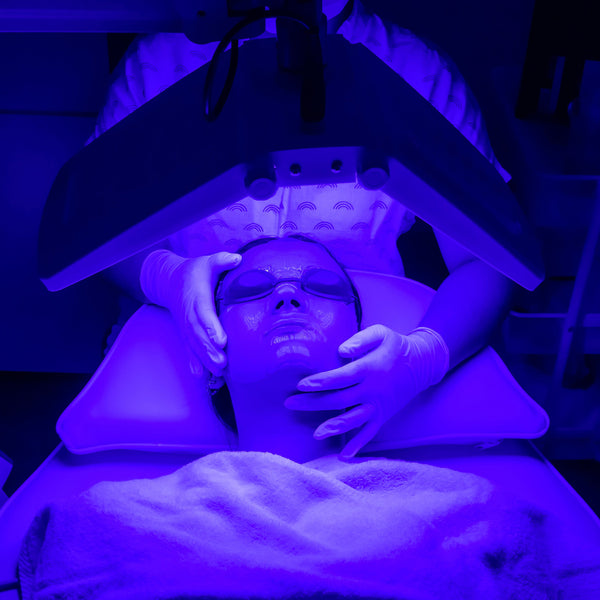Pregnancy Skin

My own fertility journey began in 2020 with two pregnancy losses, and the realization I needed to see a reproductive specialist. Endless injections and a year and a half later, I had Alexandra with the help of IVF. My condition was somewhat unique - having a blood clotting disorder, I was on anti-coagulants for 6 weeks before my embryo transfer, throughout my pregnancy, and 6 weeks postpartum to prevent any clots. Aside from the daily blood-thinner injections and some typical IVF restrictions, my pregnancy proceeded without any complications, and my skincare regimen remained uncomplicated, although with some adjustments. While everyone is different, and each pregnancy is unique, in this article, I tried to highlight some of the more commonplace skin conditions and changes that pregnancy brings on. Almost a year after giving birth, I still struggle with hyperpigmentation and rosacea but try not to be overly hard on myself.
Hyperpigmentation
One of the most common pregnancy-related skin conditions is melasma, and this is not a new phenomenon – the darkening of facial skin during pregnancy has been documented for more than 2,000 years.
Melasma is also known as chloasma faciei or pregnancy mask and has a direct relationship to female hormonal activity, as is frequently associated with pregnancy and the use of oral contraceptive pills. Although we may not instantly put melasma in the category of genetic hyperpigmentation, genetic factors do play a role. More than 30% of patients have a family history of the condition, with the incidence being highest among people with light brown skin who live in regions where the sun is strong. Women account for 90% of all melasma cases, but men may develop it, as well. The most common manifestations of pregnancy mask appear in patches and affect the cheeks, upper lip, chin, nose, and forehead.
In a 2016 University of Pennsylvania study, human melanocytes were exposed to estrogen levels usually seen during the gestational period. In turn - the cells responded by increasing melanin production. In addition to that, ethinyl estradiol, a synthetic version of estrogen used in birth control pills, had a similar effect. Researchers already had an inkling when it was noted that women sometimes develop melasma when taking birth control pills which contain only derivatives of the hormone estrogen. Interestingly enough, when the melanocytes were exposed to progesterone, melanin production decreased, leading to skin lightening. In short, the hyperpigmentation caused by estrogen is offset by the lightening effects of progesterone.
Other factors to take into consideration if you or your clients have melasma are photosensitizing medications, ovarian or thyroid dysfunction, and certain skin care products and devices. Since the sun can exasperate melasma, the first line of defense against this type of hyperpigmentation is an SPF of 30 or higher re-applied every two hours. I advise my clients to not begin a hyperpigmentation treatment while they are still pregnant or breastfeeding, but to wait until they are finished with nursing, and continue using a mineral SPF and hydrating products until then. In addition to most brightening products like retinols and derivatives of hydroquinone (including alpha arbutin - Hydroquinone β-D-glucopyranoside) are contraindicated while during gestation and while breastfeeding. The good news is that hormones usually level off months after delivery and after the discontinuation of lactating, and most women report a significant reduction of melasma at that time.
Having a results-oriented product line is one part of the equation, the other is the right tools and equipment. Peels and brightening products, in recent years leaning towards the non-hydroquinone option, are just two ways to topically treat hormonal hyperpigmentation. The most effective lasers are not accessible to aestheticians practicing in most states and are only to be operated by nurses under the supervision of a medical doctor. In a medical aesthetics practice, physicians, nurses, physician assistants, and aestheticians are allowed to work with these devices. In most states, only a physician or registered nurse can operate intense pulsed light and laser machines.
Since melanin has a broad-absorption-spectrum (630 to 1100 nanometers), a variety of lasers and light sources can be used. Melanosomes have a short thermal relaxation time (50 to 500 nanoseconds). Longer wavelengths penetrate deeper to target the dermal pigment, but melanin absorption is better with shorter wavelengths. Q-switched lasers, fractional lasers, ablative lasers, intense pulsed light, copper bromide laser, thulium laser, and their combinations have all been used, but response is unpredictable. Q-switched yttrium-aluminum-garnet laser has been the top choice for some cases of melasma, especially in individuals with darker skin tones. A series of six laser treatments is recommended, and the cost is usually around $500 to $1200. Like all laser treatments, this protocol should be postponed until after delivery, and the series ideally start in the fall and wintertime, while the sun is not at its brightest. In addition to the professional treatments, it is imperative that the client follows the homecare protocol and uses brightening products and sunscreen between treatments.
Stretch marks
Another common condition during gestation is stretch marks, or striae distensae, which may manifest on the stomach, thighs, flanks, buttocks or breasts. Striae gravidarum is the term for striae distensae occurring specifically in pregnancy. Stretch marks affect as many as 8 out of 10 women during pregnancy, and can first manifest as red, purple, pink or brown depending on the skin tone. New stretch marks (striae rubrae) may feel slightly raised and itchy. Usually, they will first appear towards the end of the second trimester, although some women may not get them at all. Fluctuating hormone levels seem to be a major factor, as they cause the weakening of collagen fibers in our tissues. You may also have a higher tendency to develop stretch marks if it runs in your family. Topical or oral corticosteroids may also contribute to rapid stretch mark formation. Those gravid with multiples are more likely to experience stretch marks, as the abdomen grows fairly quickly, and the skin doesn’t have sufficient time to catch up. As the body expands faster than the skin, the skin stretches and breaks. Striae albae are postpartum hypopigmented stretch marks which appear white or silver and are chronic.
No two pregnancies are the same, and there is no one proven way to prevent or to get rid of stretch marks, but keeping the skin hydrated and moisturized at all times seems to be the best preventative treatment. A 2016 University of Manchester study by A. Bayat et al concluded that there is no topical formulation, which is shown to be 100% effective in eradicating stretch marks, but the prophylactic use of Trofolastin starting at week 12 until end of gestation demonstrated the best results. In women with a history of striae during puberty, Trofolastin caused a complete prevention of stretch marks in 89% of the cases whereas in the placebo group all the women developed striae. The active ingredients in Trofolastin are Triticum vulgare (wheat) oil, centella asiatica (Gotu Kola), hydrolyzed collagen and elastin. The same study showed that popular ingredients like cocoa butter and olive oil which did not demonstrate any effect.
Acne
Acne in pregnancy can happen due to hormonal changes and overproduction of sebum triggered by progesterone. The blemishes can appear as pustules cysts or papules, and most commonly appear on the chin, cheeks or forehead. During the first trimester, progesterone levels rise drastically, but plateau shortly thereafter. Since progesterone is an androgen hormone, it causes the skin to produce a larger amount of thick, waxy sebum. For this reason, most acne flare-ups happen in early pregnancy. As estrogen production takes over towards the end of the pregnancy, acne symptoms usually improve. Estrogen levels increase steadily during pregnancy and reach their peak in the third trimester, which also explains hyperpigmentation closer to end of term.
The treatment of acne during pregnancy can encompass a natural product routine free of retinoids, high percentages of salicylates, and of course, Accutane. The maker of Accutane states on its website: “Accutane must not be used by female patients who are or may become pregnant. There is an extremely high risk that severe birth defects will result if pregnancy occurs while taking Accutane in any amount, even for short periods of time.”
As for salicylic acid, widely used in acne products - The American College of Obstetricians & Gynecologists (ACOG) categorizes over-the-counter topical skin care products including a salicylic acid concentration of 2% or less as safe for use in pregnancy.
As for devices to treat pregnancy-related acne, nearly all are contraindicated during pregnancy, most importantly the high frequency machine. I personally don’t use any devices on my pregnant clients, not even the steamer. I choose a gentle facial using warm steamed towels and even avoid LED light, which regularly doesn’t carry any pregnancy contraindications. From my own experience with hyperpigmentation, I came to the realization that most light and warmth does more harm than good on hormonal skin and can exasperate melasma. If you do choose to work with an LED light, I suggest avoiding the blue light (at 415 nanometer) and only using the red and infrared wavelengths for no longer than 5 minutes at every facial session.
Panel LED lights are the most convenient type of phototherapy equipment, since they don’t require direct hands-on supervision, and cover a larger treatment area than a handheld for a full treatment time. This type of modality can be added as an a-la-carte to your service menu and is also incorporated into the facial with clear serums, crèmes and masks. Clear products work best, because they allow the light to shine through, uninterrupted.
Prurigo of Pregnancy
Another type of breakout is PUPP (pruritic urticarial papules and plaques of pregnancy) usually develops towards the end of term, and manifests as red itchy hives on the stomach and/or extremities. This inflammatory condition affects about 0.6% of all pregnancies and is caused by rapid stretching of the skin. PUPP can be extremely uncomfortable because of constant pruritus, but it’s not dangerous to either mom or fetus. The treatment for this condition is usually Benadryl and a topical corticosteroid and sufferers typically improve within 2-4 weeks after delivery.
Cholestasis
A much more serious condition that causes itching during gestation is cholestasis, and it should not be ignored. Cholestasis is included in the classification of dermatoses of pregnancy because identifying it early is important to minimize potential adverse fetal outcomes. Intrahepatic cholestasis of pregnancy occurs usually towards the end of the term because of bile buildup in the liver. Eventually, bile salts enter the bloodstream, and cause intense pruritus in the palms of the hands and soles of feet quickly becomes more generalized. The pruritus persists throughout pregnancy and is worst at night. Although most cases manifest later in pregnancy, some women have experienced cholestasis as early as 7 weeks gestation. According to a 2019 study, Intrahepatic cholestasis of pregnancy is the most common liver disease of pregnancy with an incidence ranging from 0.1% to 15.6% worldwide. In addition to severe itching, symptoms include jaundice and nausea. Cholestasis is hereditary and usually reoccurs in subsequent pregnancies. Ursodeoxycholic acid is the drug of choice used for the treatment of cholestasis, as it improves maternal itching and decreases bile acids levels.
Rosacea
Although rosacea fulminans (pyoderma faciale) is not as common as the other facial dermatoses mentioned in the article, it can be incredibly acute and affect pregnant women with an aggressive explosive course that presents with superficial and cystic papules, pustules, and nodules, as well as an erythema localized to the face. Although the etiology of rosacea fulminans remains unknown, immunologic, hormonal, and vascular factors have been implicated. Azelaic acid isn’t contraindicated in pregnancy and breastfeeding, which makes Finacea gel or foam the treatment of choice.
My personal struggle with rosacea started during pregnancy and persisted for several months after. As my hormones leveled off after delivery, and I came off my thyroid medication, my overall health issues did not improve. I had sharp icepick headaches, gastric problems, and unintentional weight loss. Although I’m accustomed to putting my acne and rosacea clients on a dairy-free and gluten-free diet, it took me a while to connect my own overall ill state of health and my irritated red skin with a newly acquired gluten intolerance. Unbeknown to me, my research revealed that there is a link between pregnancy and celiac disease. In fact, many women have reported that they developed severe celiac disease symptoms shortly after becoming pregnant and giving birth. Gluten sensitivity has been heavily linked to rosacea, especially in its most severe forms.
My hyperpigmentation has notably improved, although the rosacea and digestion problems persist. I’m inclined to believe that my hormones haven’t completely regressed to normal since I’m still nursing. Usually, hormones such as estrogen and progesterone, as well as thyroid activity tend to return to pre-pregnancy levels 6-8 weeks after delivery. By contrast, the hormonal side effects of breastfeeding will remain for as long as you’re nursing. As a rule of thumb, I follow the same drug and topical product contraindications for the breastfeeding period as during gestation. My own skincare routine for the year after my daughter’s birth has consisted of gentle hydrating products with hyaluronic acid, squalane (from olives), peptides and telomere repairing Teprenone, since pregnancy and birth causes accelerated cellular aging. After finishing nursing, I plan to start incorporating a gentle Hydroxypinacolone Retinoate into my routine twice weekly at night, as well as alpha arbutin products for skin brightening. Although I didn’t experience stretch marks during my gestational period, I still take the time to keep my body moisturized and hydrated by adequate water intake and topical moisturizers. I have also been taking sun protection much more seriously after developing melasma and rosacea. I now not only protect my face with an SPF and a hat but wear mostly long sleeves and UV protective gloves every time I leave the house.










